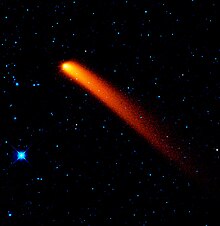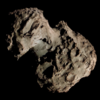
JPL Horizons On-Line Ephemeris System provides access to key Solar System data and flexible production of highly accurate ephemerides for Solar System objects.

Comet C/2006 M4 (SWAN) is a non-periodic comet discovered in late June 2006 by Robert D. Matson of Irvine, California and Michael Mattiazzo of Adelaide, South Australia in publicly available images of the Solar and Heliospheric Observatory (SOHO). These images were captured by the Solar Wind ANisotropies (SWAN) Lyman-alpha all-sky camera on board the SOHO. The comet was officially announced after a ground-based confirmation by Robert McNaught on July 12.
Comet C/2002 V1 (NEAT) is a non-periodic comet that appeared in November 2002. The comet peaked with an apparent magnitude of approximately –0.5, making it the eighth-brightest comet seen since 1935. It was seen by SOHO in February 2003. At perihelion the comet was only 0.099258 astronomical units from the Sun.

Comet McNaught, also known as the Great Comet of 2007 and given the designation C/2006 P1, is a non-periodic comet discovered on 7 August 2006 by British-Australian astronomer Robert H. McNaught using the Uppsala Southern Schmidt Telescope. It was the brightest comet in over 40 years, and was easily visible to the naked eye for observers in the Southern Hemisphere in January and February 2007.
C/2007 W1 (Boattini) is a long-period comet discovered on 20 November 2007, by Andrea Boattini at the Mt. Lemmon Survey. At the peak the comet had an apparent magnitude around 5.

C/1992 J1 (Spacewatch) is a comet that was discovered 1 May 1992 by David Rabinowitz of the Spacewatch Project. This was the first comet to be discovered using an automated system.

Comet C/2010 X1 (Elenin) is an Oort cloud comet discovered by Russian amateur astronomer Leonid Elenin on December 10, 2010, through remote control of the International Scientific Optical Network's robotic observatory near Mayhill in the U.S. state of New Mexico. The discovery was made using the automated asteroids discovery program CoLiTec. At the time of discovery, the comet had an apparent magnitude of 19.5, which made it about 150,000 times fainter than can be seen with the naked eye. The discoverer, Leonid Elenin, originally estimated that the comet nucleus was 3–4 km in diameter, but more recent estimates place the pre-breakup size of the comet at 2 km. Comet Elenin started disintegrating in August 2011, and as of mid-October 2011 was not visible even using large ground-based telescopes.
C/2000 W1 (Utsunomiya–Jones) is a long-period comet from the Oort cloud discovered on November 18, 2000, by Syogo Utsunomiya and Albert F. A. L. Jones. The comet reached up to apparent magnitude 5.5, but was only 27 degrees from the Sun in mid-December 2000.
C/1999 F1 (Catalina) is one of the longest known long-period comets. It was discovered on March 23, 1999, by the Catalina Sky Survey. The current perihelion point is outside of the inner Solar System which helps reduce planetary perturbations to this outer Oort cloud object and keep the inbound and outbound orbital periods similar.

C/1999 S4 (LINEAR) was a long-period comet discovered on September 27, 1999, by LINEAR.

(709487) 2013 BL76 is a trans-Neptunian object and centaur from the scattered disk and Inner Oort cloud approximately 30 kilometers in diameter.

C/2013 V5 (Oukaimeden) is a retrograde Oort cloud comet discovered on 12 November 2013 by Oukaimeden Observatory at an apparent magnitude of 19.4 using a 0.5-meter (20 in) reflecting telescope.

C/2013 US10 (Catalina) is an Oort cloud comet discovered on 31 October 2013 by the Catalina Sky Survey at an apparent magnitude of 19 using a 0.68-meter (27 in) Schmidt–Cassegrain telescope. From September 2015 to February 2016 the comet was around apparent magnitude 6. The comet took around a million years to complete half an orbit from its furthest distance in the Oort cloud and should be ejected from the Solar System over many millions of years.
C/2011 J2 (LINEAR) is an Oort cloud comet discovered on 4 May 2011 by LINEAR at an apparent magnitude of 19.7 using a 1-meter (39 in) Reflecting telescope. As of September 2014 the comet is around apparent magnitude 17.

C/2017 K2 (PanSTARRS) is an Oort cloud comet with an inbound hyperbolic orbit, discovered in May 2017 at a distance beyond the orbit of Saturn when it was 16 AU (2.4 billion km) from the Sun. Precovery images from 2013 were located by July. It had been in the constellation of Draco from July 2007 until August 2020. As of June 2022, the 3-sigma uncertainty in the current distance of the comet from the Sun is ±6000 km.

C/2017 U7 (PanSTARRS) is a hyperbolic comet, first observed on 29 October 2017 by astronomers of the Pan-STARRS facility at Haleakala Observatory, Hawaii, United States when the object was 7.8 AU (1.2 billion km) from the Sun. Despite being discovered only 10 days after interstellar asteroid 1I/'Oumuamua, it was not announced until March 2018 as its orbit is not strongly hyperbolic beyond most Oort Cloud comets. Based on the absolute magnitude of 10.6, it may measure tens of kilometers in diameter. As of August 2018, there is only 1 hyperbolic asteroid known, ʻOumuamua, but hundreds of hyperbolic comets are known.

C/2018 C2 (Lemmon) is a hyperbolic comet. It was first observed on 5 February 2018 by the Mount Lemmon Survey conducted at the Mount Lemmon Observatory near Tucson, Arizona, in the United States. The discovery was announced on 4 March 2018 along with another hyperbolic object, A/2017 U7. Based on the absolute magnitude of 15.1, it may measure several kilometers in diameter. On 22 March 2018 it was determined to be a hyperbolic comet.

C/2017 T2 (PanSTARRS) is an Oort cloud comet discovered on 2 October 2017 when it was 9.2 AU (1.38 billion km) from the Sun. The closest approach to Earth was on 28 December 2019 at a distance of 1.52 AU (227 million km). It came to perihelion on 4 May 2020 when it was safe from disintegration at 1.6 AU from the Sun.
C/2010 U3 (Boattini) is the hyperbolic comet with the longest observation arc and took around a million years to complete half an orbit from its furthest distance in the Oort cloud. It was discovered on 31 October 2010 by Andrea Boattini in images taken with the Mount Lemmon Survey's 1.5-m reflector. The perihelion point is outside of the inner Solar System.
C/2021 O3 (PanSTARRS) is perhaps an Oort cloud comet, discovered on 26 July 2021 by the Pan-STARRS sky survey. It came to perihelion on 21 April 2022 at 0.287 AU (42.9 million km). from the Sun.















